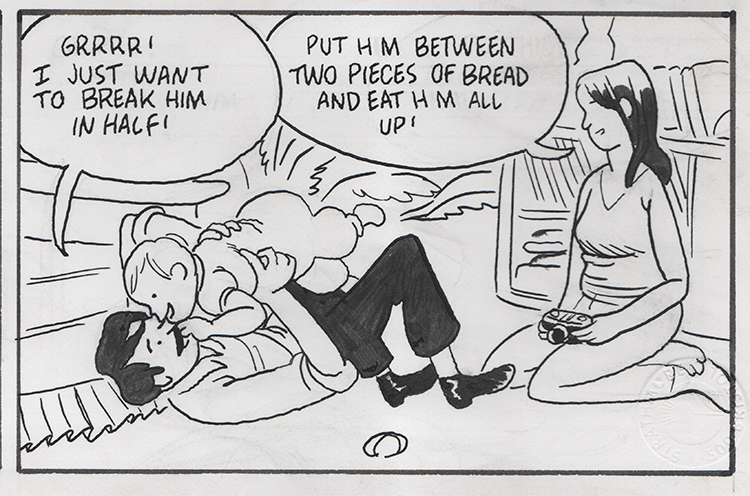Those graphic novels that are considered once-in-a-lifetime projects of significance are few and far between. Blood of the Virgin, by Sammy Harkham, is one of them. It’s as if Harkham was destined to create this book: a work about making art; the Jewish experience; and his hometown of Los Angeles. The sense of inevitability is striking. This book came out into the world as a serial, promulgated to audiences by the means of Harkham’s own comic book series, Crickets. Many a diehard fan has followed the progress of a young couple in L.A., circa 1971 - Ida stays home with the baby much of the time, while Seymour pursues dreams of making his mark as a filmmaker. While the plot covers the span of only a few weeks, it took 14 years to complete this book. And then to read the whole thing, it feels so smooth and consistent - as if it was all meant to happen just as it did.

I went back and dug up some Harkham material that I already had to enhance my advance copy reading. This process happened to coincide with my purchasing an original page from the book. While I was reading and putting together this review, I kept going back to that page, referenced as “Page 99”, with Ida and Seymour doting over their toddler son. It is a perfect example of the dark humor that permeates this book. It starts out as an innocent enough familial moment up until the last panel that indulges some dry adult wit. Seymour says, “I just want to break him in half!” Ida says, “Put him between two pieces of bread and eat him all up!” What parents say such things outside of the Addams Family? Plenty, I’m sure. More to the point, I think it speaks to the attitude of this couple: so young, with so much callow energy to burn, and a casual disregard for each other - even their pudgy little boy. Harkham never gives the reader an appealing portrait of Junior; the baby is comedy relief. In very frank terms, Harkham depicts youthful ennui and despair, all the way down to the couple’s bedroom. Seymour grabs for what he wants and when Ida objects, he storms off as if denied an entitlement. At best, Ida and Seymour have fallen into a routine where they barely tolerate each other. Harkham’s style, grounded in reality but mid-century cartoony, lures me in and dares me to take it seriously or meet it halfway.

But Harkham’s narrative is too good for me not to take seriously. I form my own opinions on the motivations of the characters. At various times, I root for them, or I am disgusted by their actions. Seymour works for a modest studio that churns out low-budget horror movies. There’s absolutely no pretense to art here; no redemptive quality on the level of Roger Corman. Somehow, Seymour seems oblivious to this. Harkham never reveals much of Seymour’s deeper thinking. Seymour’s “big break” to direct one of these clunkers is what propels much of the book. Perhaps there really isn’t all that much deep thinking going on for Seymour. At this point in his life, he is still figuring himself out. He’s a self-absorbed brat more devoted to his libido than to some well-articulated vision. Never in this story does Seymour explain his approach to filmmaking except for a brief mention of his admiration for classic horror movies. So, if you think this is a story about the great artistic struggle, it’s not - but I believe that is the whole point of what Harkham is doing here. Seymour is struggling mostly with the idea of being an artist and not with acting as an actual artist. And that’s brilliant. Seymour’s journey isn't all for naught either, as it takes us down various paths - including a history of Hollywood.

This story is as much about Ida as it is about Seymour, though it is set in an era where the man’s journey dominates. It’s Seymour’s ambition, whatever that may eventually turn out to be, that seems to be the only career that matters. Seymour gets to have his crisis - and his affairs. Ida is expected to not ask for much at all. But she does. And towards the end of this tale, Ida walks away, hops on a plane, and goes to visit family in New Zealand. Her concerns end up ringing truer than anything Seymour has confronted. Ida’s epiphanies don’t come easy, but she matures during her sojourn and this push forward toward understanding and redemption may rub off on Seymour.
As if it was all meant to be, Harkham fulfills the promise of what he started so many years ago as a full-bodied graphic novel, complete with a bittersweet resolution. So much for cartoonists who seclude themselves away from the world at some artist retreat. Don’t get me wrong. I’m not against it. But Harkham created his big book out in public. Maybe he needed that particular energy and pressure to see his work through. Whatever the case, the dedication to his process got him across the finish line. Blood of the Virgin is something that can’t help but stand the test of time - in a very literal sense, it already has.







